How Flooring Can Transform Your Home’s Entryway
First impressions are everything. When you walk through your front door, what does it say about you? Are you embarrassed by your entryway? Or do you love the ambiance it sets from the first view?
Old, shabby floors can detract. Luckily, there is a way to change it. Why not transform your entryway from the bottom up? Your flooring is a great place to start.
Flooring in the entryway does more than just look good—it needs to be functional, durable, and stylish. Let’s explore how the right flooring can elevate your home’s entryway, creating a lasting impression for you and your guests.
Why the Entryway Matters
Entryways are one of the most used spaces inside your home. It’s the first thing guests see when they walk in, and it’s the space you cross every time you leave or come home. The flooring in this high-traffic area must:
- Withstand wear and tear from shoes, dirt, and weather.
- Be easy to clean and maintain.
- Complement the overall aesthetic of your home.
With the right flooring, you can blend functionality with design, making your entryway both practical and stunning.
Flooring Options to Elevate Your Entryway
What flooring is best? While there isn’t a “perfect” choice, we do have a few flooring options we know work well in entryways.
Porcelain or Ceramic Tile: A Durable and Stylish Choice
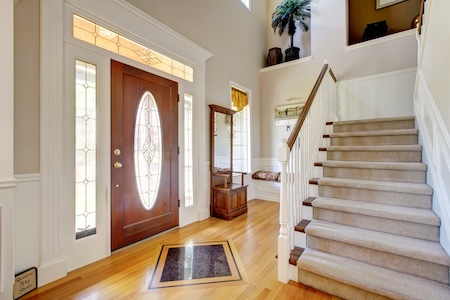 Porcelain and ceramic tiles are popular options for entryways due to their durability and water resistance. These materials can handle muddy shoes, wet umbrellas, and heavy foot traffic without showing signs of wear.
Porcelain and ceramic tiles are popular options for entryways due to their durability and water resistance. These materials can handle muddy shoes, wet umbrellas, and heavy foot traffic without showing signs of wear.
Tile is easy to clean, making it ideal for homes with kids or pets. It also comes in a variety of colors, patterns, and textures, allowing you to customize the look of your entryway.
Design Tip: Use large-format tiles or patterns like herringbone or mosaic to add visual interest while minimizing grout lines for easier cleaning.
Luxury Vinyl Plank (LVP): The Perfect Blend of Beauty and Practicality
Luxury vinyl plank offers the look of hardwood or stone with the added benefits of water resistance and scratch durability. It’s a versatile choice for entryways, providing a warm, inviting feel without sacrificing practicality.
LVP is softer underfoot than tile and can mimic the look of natural materials at a fraction of the cost. It’s also highly durable, standing up to daily wear and tear.
Design Tip: Opt for wood-look LVP in light or medium tones to create a welcoming, cozy atmosphere in your entryway.
Natural Stone: A Timeless and Elegant Option
For those looking to make a statement, natural stone such as slate, granite, or travertine is a luxurious choice for entryway flooring. Stone brings a sense of sophistication and permanence to your space.
Natural stone is incredibly durable and unique, with no two pieces looking exactly alike. Its natural texture provides slip resistance, a plus in wet or snowy climates like Colorado.
Design Tip: Pair stone flooring with complementary rugs to soften the space and add warmth.
Hardwood: Classic Charm for a Seamless Transition
Hardwood flooring brings warmth and timeless appeal to any entryway. While it may require a bit more maintenance in high-traffic areas, its aesthetic benefits often outweigh the drawbacks.
Hardwood creates a seamless flow between the entryway and adjoining rooms, making your home feel cohesive. Choose harder wood species like oak or maple for added durability.
Design Tip: Use entry mats or runners to protect the wood from scratches and moisture while adding a layer of style.
Laminate Flooring: Budget-Friendly Durability
If you love the look of hardwood but need a more affordable or low-maintenance option, laminate flooring is a fantastic alternative for entryways.
Laminate is scratch-resistant, easy to clean, and comes in a variety of styles that mimic natural wood or stone.
Design Tip: Choose a matte finish to minimize the appearance of dirt and footprints, keeping your entryway looking pristine.
Design Tips to Maximize Your Entryway Flooring
Incorporate Patterns and Borders
Adding a pattern or border to your entryway flooring can elevate the design and create a sense of structure. Consider geometric tiles or a contrasting border to make the space feel defined and intentional.
Use Rugs Strategically
Rugs and mats not only protect your flooring but also add texture, color, and warmth to the entryway. Choose rugs that complement the flooring material and are easy to clean, such as washable options for high-traffic areas.
Emphasize Continuity
For open-concept homes, continuity is key. Extending the same flooring material from the entryway into adjacent spaces creates a seamless look that makes your home feel larger and more cohesive.
Add a Statement Piece
Your entryway flooring doesn’t have to be plain. Use a bold tile pattern, unique stone variation, or rich wood tone to make the floor itself a focal point. Pair it with minimalist décor to let the flooring shine.
Maintaining Your Entryway Flooring
The entryway endures a lot of daily wear, so regular maintenance is essential to keep it looking its best. Here are some quick tips:
For Tile and Stone: Sweep regularly and use a mild cleaner to remove dirt and grime. Seal natural stone periodically to protect against stains.
For LVP and Laminate: Wipe up spills promptly and use a damp mop with a manufacturer-recommended cleaner.
For Hardwood: Sweep frequently, clean with a wood-safe cleaner, and use rugs to minimize direct contact with dirt and moisture.
Transform Your Entryway with the Right Flooring
Your entryway is more than just a passage—it’s an opportunity to showcase your style and create a welcoming first impression. The good news is there are many different flooring materials to choose from. There isn’t a right choice. Instead, it’s all about finding one that works with your lifestyle and personality, then elevating your home’s entryway to create a stunning, functional space.
Ready to transform your entryway? Let’s talk. We’d love to show you our showroom and help you to explore flooring options that fit your style and needs. Let’s create an entryway that sets the tone for your home and leaves a lasting impression.
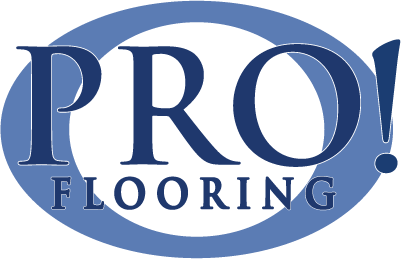
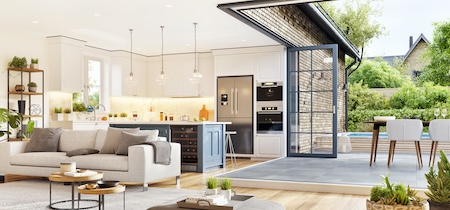 We have another reason for you too. If you put emphasis on cohesiveness between indoor outdoor spaces, it may increase property value. A well-designed and cohesive indoor-outdoor connection is often seen as a desirable feature by potential buyers. This can increase the perceived value of your property.
We have another reason for you too. If you put emphasis on cohesiveness between indoor outdoor spaces, it may increase property value. A well-designed and cohesive indoor-outdoor connection is often seen as a desirable feature by potential buyers. This can increase the perceived value of your property.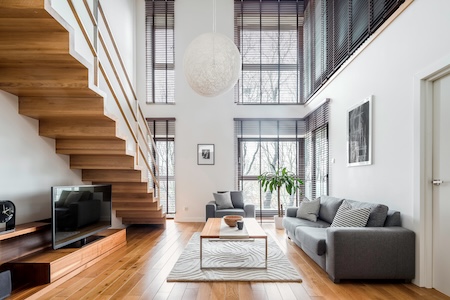 Artificial light comes from human-made sources. It can be fluorescent, incandescent, LED, or other types, each with its own color temperature and quality. Artificial light is consistent and controllable but often lacks the broad spectrum of natural light. It can sometimes make colors look different than they would in natural light, depending on the bulb’s color temperature (e.g., warm, cool, daylight).
Artificial light comes from human-made sources. It can be fluorescent, incandescent, LED, or other types, each with its own color temperature and quality. Artificial light is consistent and controllable but often lacks the broad spectrum of natural light. It can sometimes make colors look different than they would in natural light, depending on the bulb’s color temperature (e.g., warm, cool, daylight).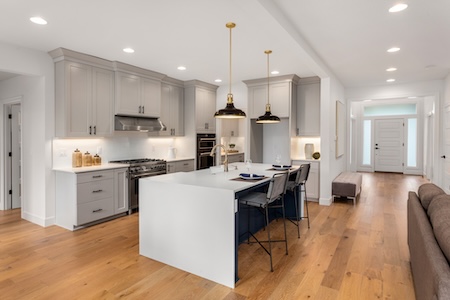 Do you routinely find yourself grabbing a broom or a mop to clean up after you’re in the kitchen? Do you have pets that spill, leave messes, and have accidents? Do you have cleaning solutions and wipes and rags at the ready?
Do you routinely find yourself grabbing a broom or a mop to clean up after you’re in the kitchen? Do you have pets that spill, leave messes, and have accidents? Do you have cleaning solutions and wipes and rags at the ready?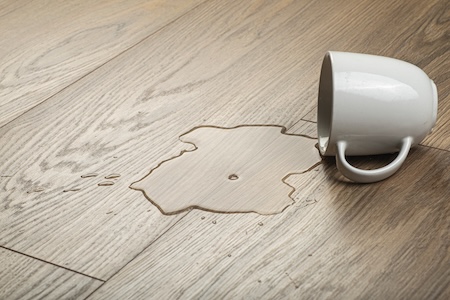 In the hardwood flooring industry, manufacturers came up with the idea of engineered hardwood as an alternative to solid hardwood flooring. The goal was to create a product that used less of the valuable hardwood species while offering enhanced stability and versatility.
In the hardwood flooring industry, manufacturers came up with the idea of engineered hardwood as an alternative to solid hardwood flooring. The goal was to create a product that used less of the valuable hardwood species while offering enhanced stability and versatility. What if you make a mistake? Professionals can guarantee their work. Many offer warranties or guarantees on their installations, giving you peace of mind that any potential issues will be addressed without additional cost.
What if you make a mistake? Professionals can guarantee their work. Many offer warranties or guarantees on their installations, giving you peace of mind that any potential issues will be addressed without additional cost.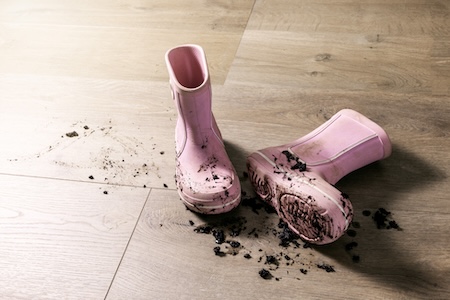 Do you see each of these inside your home? Then you already know the damage they can do.
Do you see each of these inside your home? Then you already know the damage they can do.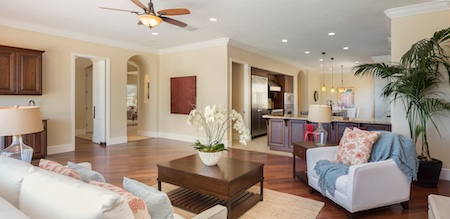 There’s very little that will impact the way it handles. In this case, “built to last” implies reliability and resilience in facing challenges. Whatever your family can dish out, it is constructed or made in a manner that ensures it will remain effective and intact for an extended duration.
There’s very little that will impact the way it handles. In this case, “built to last” implies reliability and resilience in facing challenges. Whatever your family can dish out, it is constructed or made in a manner that ensures it will remain effective and intact for an extended duration.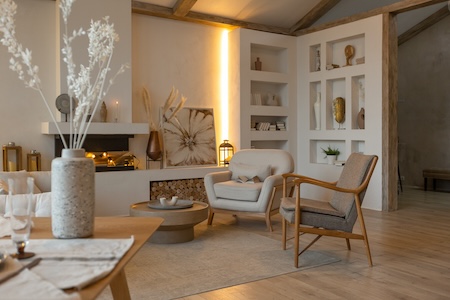 Flooring is dependent on needs as much as it is your personal liking. Solid hardwood, engineered hardwood, laminate, luxury vinyl – it all can make a welcome addition to any home. They each have their strengths and weaknesses. What matters most is that it blends with your lifestyle.
Flooring is dependent on needs as much as it is your personal liking. Solid hardwood, engineered hardwood, laminate, luxury vinyl – it all can make a welcome addition to any home. They each have their strengths and weaknesses. What matters most is that it blends with your lifestyle.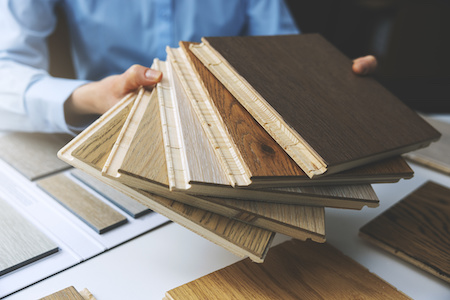 Flooring serves as the foundation, both literally and figuratively, of any interior space. The flooring choice defines the visual appeal and establishes the overall ambiance of a room. It acts as a canvas upon which the rest of the design elements come to life.
Flooring serves as the foundation, both literally and figuratively, of any interior space. The flooring choice defines the visual appeal and establishes the overall ambiance of a room. It acts as a canvas upon which the rest of the design elements come to life.